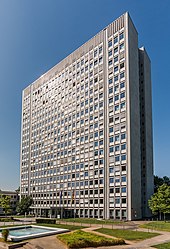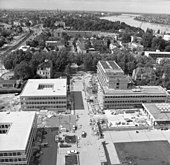Tulip field

The tulip field (also Allianz buildings am Tulpenfeld ) is an ensemble of buildings in Bonn's federal district , which was built between 1964 and 1969 on an area previously used for agriculture. It is dominated by an 18-story high-rise office building with a three-story extension, which is joined by three six-story office buildings with lower extensions and three three- story atrium buildings . The tulip field is a stop on the path of democracy history .
Location and structure
The ensemble extends in the center of the federal quarter (district Gronau ) between Helmut-Kohl-Allee ( Bundesstrasse 9 ) in the west and Winston-Churchill-Strasse / Fritz-Erler-Strasse in the east as well as Heussallee in the north and one to the "Trajektkreisel" (Helmut -Schmidt-Platz) located office building in the south. It is divided into houses 1–10, whose common address was initially Heussallee 2–10, Allianzplatz , until they were given their own house numbers in 2000 as a tulip field 1–10 .
history
The ensemble was built in six construction phases from 1964 to 1969 according to a design by the Düsseldorf architect Hanns Dustmann by Allianz AG on behalf of the federal government . Wolfgang Darius worked as a garden architect . The buildings were the result of the resolution of the German Bundestag in 1956 not to realize any further federally owned buildings in Bonn, since the city as the federal capital initially remained a temporary measure. The space that is still required should be rented. The tulip field, initially referred to as "Allianzplatz" after the client, was the first urban development ensemble in the area of the newly created parliament and government district . The ensemble was inaugurated on October 27, 1967, before a hotel ("Hotel am Tulpenfeld"; House 6) with 160 beds and a conference extension was added in the last construction phase. A restaurant ("Restaurant am Tulpenfeld"; House 8a) with further conference rooms also belonged to it, which had already been opened with the entire ensemble.
From 1968 various federal ministries were housed in the buildings; from 1978 onwards, members of the German Bundestag also had their offices there. The tulip field became known above all through the federal press conferences that have been taking place here since 1967 , which were held until August 4, 1999 in the glass hall of one of the two six-story buildings (House 7). This building was also referred to as the " press house "; Almost all Bonn correspondents of the major daily and regional newspapers, press agencies such as dpa , and some foreign correspondents were housed here. The hotel was closed in the mid-1980s and converted into an office building for the Bundestag in 1986, which also housed the Bundestag Presidium until the new plenary building was completed. The restaurant was also closed in June 1991. The Swedish embassy was located in the north of the three atrium buildings until summer 1999 (→ list of diplomatic missions ).
In the course of the relocation of the parliament and government seat to Berlin in 1999, a new use had to be found for the property . The office capacities freed up by the move out of the MPs and the ministries were reoccupied by the Federal Network Agency , which is housed in the 18-storey high-rise. The three atrium buildings are also used by the Federal Network Agency. Furthermore, were or are in the buildings organizations of development aid is home, so in 1999 the German Development Service and since 2000 the German Development Institute . That is why the tulip field was also called the “north-south center”. The former hall of the Federal Press Conference was only used sporadically from 1999, today it no longer has an active function and belongs to the Engagement Global organization located in the former press house .
The buildings were renovated from 2001 to 2006 on behalf of the federal government for around 50 million euros. Since July 2009, the tulip field complex partially stands as monument under monument protection . A lawsuit against the protected status brought by the building owner was granted in parts, so that the facade and the cubature of the building, parts of the interior (including the hall of the Federal Press Conference) and the open spaces are now under protection.
reception
“[E] an unimaginatively smooth collection of several building complexes (...). Expensive materials and elaborate workmanship cannot hide the fact that the large buildings fall out of the urban context of Bonn and have not become an integral part of communal life. The entire sequence of buildings, neither activated by traffic nor filled with life by the fluctuation of a broader public, forms an ensemble of cold splendor in an unattractive environment. "
“The often scolded alliance buildings on the tulip field by Hanns Dustmann, planned as urban planning factors, have a very peculiar character for the government district of cool detachment. (...) The smooth facades of the reinforced concrete skeleton buildings with their noble cladding create a peculiar virtual backdrop atmosphere of photographic cold. "
“The building complex of the 'tulip field' on the B 9, built between 1964 and 1969, had long since become the mighty, but typically imperceptible branch of the German Bundestag (...). Because hiding the true size and importance was one of the urban planning characteristics of this center of power - a striking correspondence between the state's self-image and the shape of the city. "
“The 'alliance buildings' on the Tulpenfeld were planned as urban planning factors and form their own accent within the government district, as it were an 'office city' that forms a closed urban planning unit that one literally enters and that is divided into itself with its spacious, traffic-free Arrangement, a spatial - even if today changed in detail - design. "
literature
- Ursel and Jürgen Zänker: Building in Bonn room 49–69. Attempt to take stock . In: Landschaftsverband Rheinland (Hrsg.): Art and antiquity on the Rhine . Guide to the Rheinisches Landesmuseum Bonn . No. 21 . Rheinland-Verlag, Düsseldorf 1969, p. 155/156 .
- Ingeborg flag : Architecture in Bonn after 1945: Buildings in the federal capital and its surroundings . Verlag Ludwig Röhrscheid, Bonn 1984, ISBN 3-7928-0479-4 , p. 107.
- Andreas Denk , Ingeborg flag: Architectural guide Bonn . Dietrich Reimer Verlag, Berlin 1997, ISBN 3-496-01150-5 , p. 91.
- Foundation House of the History of the Federal Republic of Germany , Federal Agency for Civic Education (ed.); Matthias Hannemann, Dietmar Preißler: Bonn - Places of Democracy: The Historical Travel Guide , Ch. Links Verlag 2009, pp. 40–43 .
- Angelika Schyma : Bonn, former government district, tulip field 2–10. Monument value before the administrative court in Cologne . In: Landschaftsverband Rheinland (Hrsg.): Denkmalpflege im Rheinland , 28th year No. 4, 4th quarter of 2011, pp. 181–184 (PDF; 490 kB).
Web links
- Entry on the way of democracy
- Entry for Heussallee 2–10, Allianzplatz / Tulpenfeld (Allianz buildings, press house of the German Bundestag, federal press conference / regulatory authority for telecommunications and post) in the database " KuLaDig " of the Rhineland Regional Association (with a brief description of the LVR office for the preservation of monuments in the Rhineland by Angelika Schyma and Elke Janßen-Schnabel, 2005)
Individual evidence
- ↑ List of streets in the Bonn district of Gronau
- ↑ The Lord Mayor of Bonn (Ed.); Friedrich Busmann : From the parliament and government district to the federal district. A Bonn development measure 1974-2004 . Bonn, June 2004, p. 33.
- ^ Karl Gutzmer : Chronicle of the city of Bonn . Chronik-Verlag, Dortmund 1988, ISBN 3-611-00032-9 , p. 237.
- ↑ a b The last free pub closes , Das Ostpreußenblatt, July 6, 1991
- ↑ Not fussy . In: Der Spiegel . No. 31 , 1986, pp. 34-36 ( online - 28 July 1986 ).
- ↑ Ursula Salentin: I'll stay Rita Süssmuth: a biography . Herder, Freiburg im Breisgau 1993, ISBN 978-3-451-04162-4 , p. 9.
- ↑ a b The Lord Mayor of Bonn (Ed.); Friedrich Busmann : From the parliament and government district to the federal district. A Bonn development measure 1974-2004 . Bonn, June 2004, p. 105.
- ↑ Bonn Federal Network Agency spreads in the tulip field , General-Anzeiger , October 13, 2006
- ↑ Schröder invites experienced reformers to Bonn , Sueddeutsche Zeitung , September 2004.
- ↑ The old hall of the Federal Press Conference opens its doors , General-Anzeiger , September 9, 2013.
- ↑ monument list of Bonn (Updated March 15, 2019), number A 4056 .
- ^ A b Angelika Schyma : Bonn, former government district, Tulpenfeld 2–10. Monument value before the administrative court in Cologne . In: Landschaftsverband Rheinland (Hrsg.): Denkmalpflege im Rheinland , 28th year No. 4, 4th quarter of 2011, pp. 181–184 (PDF; 490 kB).
- ^ Frank-Lothar Kroll: Federal capital Bonn. A Danaer present? In: Federal Ministry for Building, Regional Planning and Urban Development (Ed.): Forty Years Federal Capital Bonn 1949–1989 . CF Müller, Karlsruhe 1989, ISBN 3-7880-9780-9 , pp. 92-115 (here: pp. 109/110).
- ↑ Angelika Schyma: "A small town in Germany" - the government district of the former federal capital . In: Landschaftsverband Rheinland , Rheinisches Amt für Denkmalpflege : Denkmalpflege im Rheinland , ISSN 0177-2619 , Volume 16, No. 2, 1999, pp. 49-62 (here: pp. 55/56).
Coordinates: 50 ° 42 ′ 56.6 " N , 7 ° 7 ′ 25.7" E


